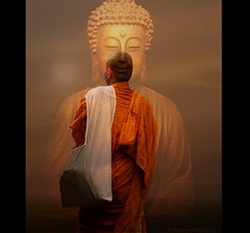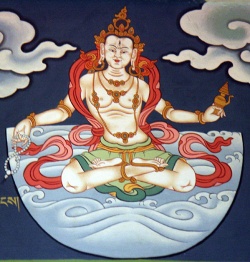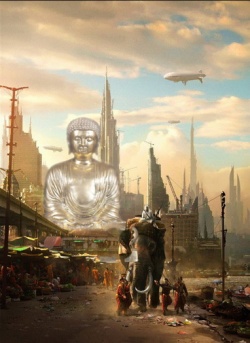Difference between revisions of "Are nirmaṇakāyas philosophical zombies?"
(Created page with "{{DisplayImages|284|232|1053|1265|2015}} {{Centre|<big><big>Are nirmaṇakāyas philosophical zombies? </big></big><br/> By Indrajala (Jeffrey Kotyk)}}<br/><br/> The nirm...") |
|||
| Line 3: | Line 3: | ||
By [[Indrajala (Jeffrey Kotyk)]]}}<br/><br/> | By [[Indrajala (Jeffrey Kotyk)]]}}<br/><br/> | ||
| − | The nirmaṇakāya in Mahāyāna thought is essentially conceived of as a seemingly physical and tangible manifestation of an otherwise transcendental Buddha. In other words, it is a means through which that transcendental force interacts with ordinary beings in a way they can comprehend. | + | The [[nirmaṇakāya]] in [[Mahāyāna]] [[thought]] is [[essentially]] conceived of as a seemingly [[physical]] and [[tangible]] [[manifestation]] of an otherwise [[transcendental]] [[Buddha]]. In other words, it is a means through which that [[transcendental]] force interacts with [[ordinary beings]] in a way they can comprehend. |
| − | This might lead to the question, "Are nirmaṇakāyas {{Wiki|philosophical zombies}}?" A philosophical zombie is a hypothetical entity that for all intents and purposes is identical with a living being though lacking experience, consciousness, qualia and/or sentience. This is worth considering because a Buddha fundamentally is the dharmakāya which while encompassing all beings and all reality, is not a being (sattva). The dharmakāya is the body of truth and the body of reality. It is the eternal principle of emptiness. Hence, it is free of all marks and characteristics such as physical form, consciousness or senses. It then begs the question of what a seemingly flesh and blood Śākyamuni Buddha was. | + | This might lead to the question, "Are [[nirmaṇakāyas]] {{Wiki|philosophical zombies}}?" A [[philosophical]] [[zombie]] is a {{Wiki|hypothetical}} [[entity]] that for all intents and purposes is [[identical]] with a [[living being]] though lacking [[experience]], [[consciousness]], {{Wiki|qualia}} and/or [[sentience]]. This is worth considering because a [[Buddha]] fundamentally is the [[dharmakāya]] which while encompassing all [[beings]] and all [[reality]], is not a being ([[sattva]]). The [[dharmakāya]] is the [[body of truth]] and the [[body of reality]]. It is the [[eternal principle of emptiness]]. Hence, it is free of all marks and [[characteristics]] such as [[physical]] [[form]], [[consciousness]] or [[senses]]. It then begs the question of what a seemingly flesh and {{Wiki|blood}} [[Śākyamuni Buddha]] was. |
| − | To investigate this question I think we might consider the ideas of Kumārajīva 鳩摩羅什 (344-413), the great Central Asian translator of texts in fifth-century China. | + | To investigate this question I think we might consider the [[ideas]] of [[Kumārajīva]] [[鳩摩羅什]] (344-413), the great {{Wiki|Central Asian}} [[translator]] of texts in fifth-century [[China]]. |
| − | Firstly, looking briefly at Kumārajīva's ideas in his dialogue with Huiyuan 慧遠 (334-416), he explains that the dharmakāya is conventionally able to teach the sūtras with an illusory body via a relationship like the sun to sunlight. The question Huiyuan poses is why bodhisattvas are able to perceive the Buddha, which is the dharmakāya, teaching the dharma. Huiyuan's question is as follows. | + | Firstly, looking briefly at [[Kumārajīva's]] [[ideas]] in his {{Wiki|dialogue}} with [[Huiyuan]] [[慧遠]] (334-416), he explains that the [[dharmakāya]] is {{Wiki|conventionally}} able to teach the [[sūtras]] with an [[illusory body]] via a relationship like the {{Wiki|sun}} to sunlight. The question [[Huiyuan]] poses is why [[bodhisattvas]] are able to {{Wiki|perceive}} the [[Buddha]], which is the [[dharmakāya]], [[teaching]] the [[dharma]]. Huiyuan's question is as follows. |
: 《鳩摩羅什法師大義》卷1:「遠問曰。佛於法身中為菩薩說經。法身菩薩乃能見之。如此則有四大五根。若然者。與色身復何差別。而云法身耶。經云法身無去無來。無有起滅。泥洹同像。云何可見。而復講說乎。」(CBETA, T45, no. 1856, p. 122, c6-10) | : 《鳩摩羅什法師大義》卷1:「遠問曰。佛於法身中為菩薩說經。法身菩薩乃能見之。如此則有四大五根。若然者。與色身復何差別。而云法身耶。經云法身無去無來。無有起滅。泥洹同像。云何可見。而復講說乎。」(CBETA, T45, no. 1856, p. 122, c6-10) | ||
| − | : "Huiyuan asks, 'The Buddha as the dharmakāya teaches sūtras to the bodhisattvas. The bodhisattvas are able to see the dharmakāya. If it is like this, then it would have the four elements and five faculties. If so, what difference is there with a form body, and why call it a dharmakāya? The sūtras state that the dharmakāya is without going and without coming. It has no arising and no cessation, always like nirvāṇa. How are they able to see it and furthermore [how is it] able to teach?'" | + | : "[[Huiyuan]] asks, 'The [[Buddha]] as the [[dharmakāya]] teaches [[sūtras]] to the [[bodhisattvas]]. The [[bodhisattvas]] are able to see the [[dharmakāya]]. If it is like this, then it would have the [[four elements]] and [[five faculties]]. If so, what difference is there with a [[form body]], and why call it a [[dharmakāya]]? The [[sūtras]] state that the [[dharmakāya]] is without going and without coming. It has no [[arising]] and no [[cessation]], always like [[nirvāṇa]]. How are they able to see it and furthermore [how is it] able to teach?'" |
| − | Kumārajīva replies to this by introducing the idea of an illusory body. | + | [[Kumārajīva]] replies to this by introducing the [[idea]] of an [[illusory body]]. |
: 《鳩摩羅什法師大義》卷1:「什答曰。佛法身者。同於變化。化無四大五根。」(CBETA, T45, no. 1856, p. 122, c11-12) | : 《鳩摩羅什法師大義》卷1:「什答曰。佛法身者。同於變化。化無四大五根。」(CBETA, T45, no. 1856, p. 122, c11-12) | ||
| − | : "Kumārajīva replies, 'The Buddha's dharmakāya is the same as an illusion. It is without the four elements and five faculties.'" | + | : "[[Kumārajīva]] replies, 'The [[Buddha's]] [[dharmakāya]] is the same as an [[illusion]]. It is without the [[four elements]] and [[five faculties]].'" |
| − | The thing to note here is that the illusory bodies are described as extensions of the dharmakāya. In one sense, they are the dharmakāya, but the true dharmakāya is not actually being perceived, but just a provisional manifestation of it, just as the sunlight while born from the sun is not the sun itself. These illusory bodies, like the dharmakāya, are further described as having the quality of an image in a mirror. | + | The thing to note here is that the [[illusory]] [[bodies]] are described as extensions of the [[dharmakāya]]. In one [[sense]], they are the [[dharmakāya]], but the true [[dharmakāya]] is not actually being [[perceived]], but just a [[provisional manifestation]] of it, just as the sunlight while born from the {{Wiki|sun}} is not the {{Wiki|sun}} itself. These [[illusory]] [[bodies]], like the [[dharmakāya]], are further described as having the quality of an image in a [[mirror]]. |
: 《鳩摩羅什法師大義》卷1:「如鏡中像。水中月。見如有色。而無觸等。則非色也。化亦如是。法身亦然。又經言法身者。或說佛所化身。或說妙行法身。」(CBETA, T45, no. 1856, p. 122, c20-23) | : 《鳩摩羅什法師大義》卷1:「如鏡中像。水中月。見如有色。而無觸等。則非色也。化亦如是。法身亦然。又經言法身者。或說佛所化身。或說妙行法身。」(CBETA, T45, no. 1856, p. 122, c20-23) | ||
| − | : "Like the image in a mirror or a moon in the water, it appears to have form, but there is no tactile [quality] to it, therefore it is not form. The illusion is also like this. The dharmakāya is also so. Again, the sūtras speak of a dharmakāya, others explain an illusionary body of the Buddha, while others explain it as a dharmakāya of excellent practices." | + | : "Like the image in a [[mirror]] or a [[moon]] in the [[water]], it appears to have [[form]], but there is no {{Wiki|tactile}} [quality] to it, therefore it is not [[form]]. The [[illusion]] is also like this. The [[dharmakāya]] is also so. Again, the [[sūtras]] speak of a [[dharmakāya]], others explain an [[illusionary body]] of the [[Buddha]], while others explain it as a [[dharmakāya]] of {{Wiki|excellent}} practices." |
| − | The relationship between the two as noted above is akin to the sun and sunlight. See the following. | + | The relationship between the two as noted above is akin to the {{Wiki|sun}} and sunlight. See the following. |
: 《鳩摩羅什法師大義》卷1:「真法身者。猶如日現。所化之身同若日光。」(CBETA, T45, no. 1856, p. 123, a9-10) | : 《鳩摩羅什法師大義》卷1:「真法身者。猶如日現。所化之身同若日光。」(CBETA, T45, no. 1856, p. 123, a9-10) | ||
| − | : "The true dharmakāya is like the sun manifest. The illusionary body is like the sunlight." | + | : "The true [[dharmakāya]] is like the {{Wiki|sun}} [[manifest]]. The [[illusionary body]] is like the sunlight." |
| − | He also explains a difference between the "true body" of the Buddha and the innumerable illusory ones which arise from the former. The former is also beyond the three realms which ordinary beings inhabit. Again, in his words: | + | He also explains a difference between the "true [[body]]" of the [[Buddha]] and the {{Wiki|innumerable}} [[illusory]] ones which arise from the former. The former is also beyond the [[three realms]] which [[ordinary beings]] inhabit. Again, in his words: |
: 《鳩摩羅什法師大義》卷1:「真法身者。遍滿十方虛空法界。光明悉照無量國土。說法音聲。常周十方無數之國。具足十住菩薩之眾。乃得聞法。從是佛身方便現化。常有無量無邊化佛。遍於十方。隨眾生類若干差品。而為現形。光明色像。精麁不同。如來真身。九住菩薩尚不能見。何況惟越致及餘眾生。所以者何。佛法身者。出於三界。不依身口心行。無量無漏諸淨功德本行所成。」(CBETA, T45, no. 1856, p. 122, c29-p. 123, a8) | : 《鳩摩羅什法師大義》卷1:「真法身者。遍滿十方虛空法界。光明悉照無量國土。說法音聲。常周十方無數之國。具足十住菩薩之眾。乃得聞法。從是佛身方便現化。常有無量無邊化佛。遍於十方。隨眾生類若干差品。而為現形。光明色像。精麁不同。如來真身。九住菩薩尚不能見。何況惟越致及餘眾生。所以者何。佛法身者。出於三界。不依身口心行。無量無漏諸淨功德本行所成。」(CBETA, T45, no. 1856, p. 122, c29-p. 123, a8) | ||
| − | : "The true dharmakāya pervades the empty dharma-realm of the ten direction, its light completely illuminating immeasurable lands. The sound of the dharma being taught always encompassing innumerable realms of the ten directions. The masses of bodhisattvas fully abiding on the tenth stage are able to hear [that] dharma. From the Buddha's body there provisionally (upaya) manifest illusions, there always being immeasurable and unlimited illusory buddhas pervading the ten directions, manifesting forms appropriate to the differences in dispositions of sentient beings, differing in brilliance, physical appearance, fineness and coarseness. The true body of the Tathāgata is not even capable of being seen by ninth stage bodhisattvas. How much more so those who have achieved non-retrogression (avaivartika) and other sentient beings? The reason for this is that the Buddha's dharmakāya is beyond the three realms, not relying upon karma of the body, speech or mind, having been perfected by immeasurable and untainted pure merit and past deeds." | + | : "The true [[dharmakāya]] pervades the [[empty]] [[dharma-realm]] of the ten [[direction]], its {{Wiki|light}} completely [[illuminating]] [[immeasurable]] lands. The [[sound]] of the [[dharma]] being [[taught]] always encompassing {{Wiki|innumerable}} [[realms]] of the [[ten directions]]. The masses of [[bodhisattvas]] fully abiding on the tenth stage are able to hear [that] [[dharma]]. From the [[Buddha's]] [[body]] there provisionally ([[upaya]]) [[manifest]] [[illusions]], there always being [[immeasurable]] and [[unlimited]] [[illusory]] [[buddhas]] pervading the [[ten directions]], [[manifesting]] [[forms]] appropriate to the differences in dispositions of [[sentient beings]], differing in [[brilliance]], [[physical]] [[appearance]], fineness and coarseness. The true [[body]] of the [[Tathāgata]] is not even capable of being seen by ninth stage [[bodhisattvas]]. How much more so those who have achieved non-retrogression ([[avaivartika]]) and other [[sentient beings]]? The [[reason]] for this is that the [[Buddha's]] [[dharmakāya]] is beyond the [[three realms]], not relying upon [[karma]] of the [[body]], {{Wiki|speech}} or [[mind]], having been perfected by [[immeasurable]] and untainted [[pure]] [[merit]] and {{Wiki|past}} [[deeds]]." |
| − | So, as to whether these nirmaṇakāyas are philosophical zombies or not, I would say judging from Kumārajīva's ideas, that this would be the case. | + | So, as to whether these [[nirmaṇakāyas]] are [[philosophical]] [[zombies]] or not, I would say judging from [[Kumārajīva's]] [[ideas]], that this would be the case. |
| − | A nirmaṇakāya might be better thought of as a reaction brought about from the sufferings of beings and the past aspirations of a Buddha coming into fruition. As is commonly said in Mahāyāna the Tathāgata arises where there are beings that suffer. Such a reaction is characterized as being illusory and intangible, albeit still perceived. If a nirmaṇakāya possessed ordinary consciousness and sense faculties these would presumably be a result of afflicted karma, which a Buddha is entirely free from. To say on the other hand the faculties arise due to non-afflicted karma is perhaps equally problematic because it raises the question of how that specific karma would arise when there actually is no more being to produce such action. A bodhisattva is a sentient being (sattva), and thus their non-afflicted karma and its results are reasonable because the bodhisattva is still an individuated and distinguishable being, but in the case of a Buddha which stands nowhere like infinite space, from whence would that karma arise? | + | A [[nirmaṇakāya]] might be better [[thought]] of as a {{Wiki|reaction}} brought about from the [[sufferings]] of [[beings]] and the {{Wiki|past}} [[aspirations]] of a [[Buddha]] coming into [[fruition]]. As is commonly said in [[Mahāyāna]] the [[Tathāgata]] arises where there are [[beings]] that [[suffer]]. Such a {{Wiki|reaction}} is characterized as being [[illusory]] and intangible, albeit still [[perceived]]. If a [[nirmaṇakāya]] possessed ordinary [[consciousness]] and [[sense faculties]] these would presumably be a result of afflicted [[karma]], which a [[Buddha]] is entirely free from. To say on the other hand the [[faculties]] arise due to non-afflicted [[karma]] is perhaps equally problematic because it raises the question of how that specific [[karma]] would arise when there actually is no more being to produce such [[action]]. A [[bodhisattva]] is a [[sentient being]] ([[sattva]]), and thus their non-afflicted [[karma]] and its results are reasonable because the [[bodhisattva]] is still an individuated and distinguishable being, but in the case of a [[Buddha]] which stands nowhere like [[infinite space]], from whence would that [[karma]] arise? |
| − | From a more basic Abhidharma perspective one needs a certain set of faculties for ordinary perception and awareness. As the nirmaṇakāya is neither composed of elements or faculties, we may infer that it would not have an awareness or perception, being an illusory body of the dharmakāya. It has the quality of a moon in the water or a reflection in the mirror. Visible, but not tangible. | + | From a more basic [[Abhidharma]] {{Wiki|perspective}} one needs a certain set of [[faculties]] for ordinary [[perception]] and [[awareness]]. As the [[nirmaṇakāya]] is neither composed of [[elements]] or [[faculties]], we may infer that it would not have an [[awareness]] or [[perception]], being an [[illusory body]] of the [[dharmakāya]]. It has the quality of a [[moon]] in the [[water]] or a {{Wiki|reflection}} in the [[mirror]]. [[Visible]], but not [[tangible]]. |
| − | One might suggest the nirmaṇakāya is a non-volitional reaction (hence not karma as volitional action) spurn from the immeasurable qualities of the dharmakāya, though not relying on karma of body, speech and mind. Thus, it would qualify as being a philosophical zombie. | + | One might suggest the [[nirmaṇakāya]] is a non-volitional {{Wiki|reaction}} (hence not [[karma]] as [[volitional action]]) spurn from the [[immeasurable]] qualities of the [[dharmakāya]], though not relying on [[karma]] of [[body, speech and mind]]. Thus, it would qualify as being a {{Wiki|philosophical zombie}}. |
{{R}} | {{R}} | ||
Revision as of 20:54, 14 July 2014
Are nirmaṇakāyas philosophical zombies?
By Indrajala (Jeffrey Kotyk)
The nirmaṇakāya in Mahāyāna thought is essentially conceived of as a seemingly physical and tangible manifestation of an otherwise transcendental Buddha. In other words, it is a means through which that transcendental force interacts with ordinary beings in a way they can comprehend.
This might lead to the question, "Are nirmaṇakāyas philosophical zombies?" A philosophical zombie is a hypothetical entity that for all intents and purposes is identical with a living being though lacking experience, consciousness, qualia and/or sentience. This is worth considering because a Buddha fundamentally is the dharmakāya which while encompassing all beings and all reality, is not a being (sattva). The dharmakāya is the body of truth and the body of reality. It is the eternal principle of emptiness. Hence, it is free of all marks and characteristics such as physical form, consciousness or senses. It then begs the question of what a seemingly flesh and blood Śākyamuni Buddha was.
To investigate this question I think we might consider the ideas of Kumārajīva 鳩摩羅什 (344-413), the great Central Asian translator of texts in fifth-century China.
Firstly, looking briefly at Kumārajīva's ideas in his dialogue with Huiyuan 慧遠 (334-416), he explains that the dharmakāya is conventionally able to teach the sūtras with an illusory body via a relationship like the sun to sunlight. The question Huiyuan poses is why bodhisattvas are able to perceive the Buddha, which is the dharmakāya, teaching the dharma. Huiyuan's question is as follows.
- 《鳩摩羅什法師大義》卷1:「遠問曰。佛於法身中為菩薩說經。法身菩薩乃能見之。如此則有四大五根。若然者。與色身復何差別。而云法身耶。經云法身無去無來。無有起滅。泥洹同像。云何可見。而復講說乎。」(CBETA, T45, no. 1856, p. 122, c6-10)
- "Huiyuan asks, 'The Buddha as the dharmakāya teaches sūtras to the bodhisattvas. The bodhisattvas are able to see the dharmakāya. If it is like this, then it would have the four elements and five faculties. If so, what difference is there with a form body, and why call it a dharmakāya? The sūtras state that the dharmakāya is without going and without coming. It has no arising and no cessation, always like nirvāṇa. How are they able to see it and furthermore [how is it] able to teach?'"
Kumārajīva replies to this by introducing the idea of an illusory body.
- 《鳩摩羅什法師大義》卷1:「什答曰。佛法身者。同於變化。化無四大五根。」(CBETA, T45, no. 1856, p. 122, c11-12)
- "Kumārajīva replies, 'The Buddha's dharmakāya is the same as an illusion. It is without the four elements and five faculties.'"
The thing to note here is that the illusory bodies are described as extensions of the dharmakāya. In one sense, they are the dharmakāya, but the true dharmakāya is not actually being perceived, but just a provisional manifestation of it, just as the sunlight while born from the sun is not the sun itself. These illusory bodies, like the dharmakāya, are further described as having the quality of an image in a mirror.
- 《鳩摩羅什法師大義》卷1:「如鏡中像。水中月。見如有色。而無觸等。則非色也。化亦如是。法身亦然。又經言法身者。或說佛所化身。或說妙行法身。」(CBETA, T45, no. 1856, p. 122, c20-23)
- "Like the image in a mirror or a moon in the water, it appears to have form, but there is no tactile [quality] to it, therefore it is not form. The illusion is also like this. The dharmakāya is also so. Again, the sūtras speak of a dharmakāya, others explain an illusionary body of the Buddha, while others explain it as a dharmakāya of excellent practices."
The relationship between the two as noted above is akin to the sun and sunlight. See the following.
- 《鳩摩羅什法師大義》卷1:「真法身者。猶如日現。所化之身同若日光。」(CBETA, T45, no. 1856, p. 123, a9-10)
- "The true dharmakāya is like the sun manifest. The illusionary body is like the sunlight."
He also explains a difference between the "true body" of the Buddha and the innumerable illusory ones which arise from the former. The former is also beyond the three realms which ordinary beings inhabit. Again, in his words:
- 《鳩摩羅什法師大義》卷1:「真法身者。遍滿十方虛空法界。光明悉照無量國土。說法音聲。常周十方無數之國。具足十住菩薩之眾。乃得聞法。從是佛身方便現化。常有無量無邊化佛。遍於十方。隨眾生類若干差品。而為現形。光明色像。精麁不同。如來真身。九住菩薩尚不能見。何況惟越致及餘眾生。所以者何。佛法身者。出於三界。不依身口心行。無量無漏諸淨功德本行所成。」(CBETA, T45, no. 1856, p. 122, c29-p. 123, a8)
- "The true dharmakāya pervades the empty dharma-realm of the ten direction, its light completely illuminating immeasurable lands. The sound of the dharma being taught always encompassing innumerable realms of the ten directions. The masses of bodhisattvas fully abiding on the tenth stage are able to hear [that] dharma. From the Buddha's body there provisionally (upaya) manifest illusions, there always being immeasurable and unlimited illusory buddhas pervading the ten directions, manifesting forms appropriate to the differences in dispositions of sentient beings, differing in brilliance, physical appearance, fineness and coarseness. The true body of the Tathāgata is not even capable of being seen by ninth stage bodhisattvas. How much more so those who have achieved non-retrogression (avaivartika) and other sentient beings? The reason for this is that the Buddha's dharmakāya is beyond the three realms, not relying upon karma of the body, speech or mind, having been perfected by immeasurable and untainted pure merit and past deeds."
So, as to whether these nirmaṇakāyas are philosophical zombies or not, I would say judging from Kumārajīva's ideas, that this would be the case.
A nirmaṇakāya might be better thought of as a reaction brought about from the sufferings of beings and the past aspirations of a Buddha coming into fruition. As is commonly said in Mahāyāna the Tathāgata arises where there are beings that suffer. Such a reaction is characterized as being illusory and intangible, albeit still perceived. If a nirmaṇakāya possessed ordinary consciousness and sense faculties these would presumably be a result of afflicted karma, which a Buddha is entirely free from. To say on the other hand the faculties arise due to non-afflicted karma is perhaps equally problematic because it raises the question of how that specific karma would arise when there actually is no more being to produce such action. A bodhisattva is a sentient being (sattva), and thus their non-afflicted karma and its results are reasonable because the bodhisattva is still an individuated and distinguishable being, but in the case of a Buddha which stands nowhere like infinite space, from whence would that karma arise?
From a more basic Abhidharma perspective one needs a certain set of faculties for ordinary perception and awareness. As the nirmaṇakāya is neither composed of elements or faculties, we may infer that it would not have an awareness or perception, being an illusory body of the dharmakāya. It has the quality of a moon in the water or a reflection in the mirror. Visible, but not tangible.
One might suggest the nirmaṇakāya is a non-volitional reaction (hence not karma as volitional action) spurn from the immeasurable qualities of the dharmakāya, though not relying on karma of body, speech and mind. Thus, it would qualify as being a philosophical zombie.




